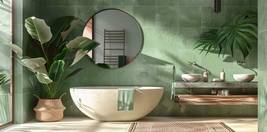Secrets of Savvy Kitchen Design

Kitchen Layout: The Heart of Functional Design
Imagine a kitchen where every utensil, pot, and ingredient was exactly where you needed it, not because of magic, but because of meticulous design. This isn't fantasy; it's the foundation of any great kitchen layout. Tradespeople with years of experience suggest starting with the "work triangle." This layout principle involves placing the stove, sink, and refrigerator in a triangular formation to minimize unnecessary steps. While this might sound like a simple dance routine, getting it right can feel more like choreographing a ballet—without stepping on anyone’s toes!
Furthermore, incorporating ample counter space near each key appliance facilitates smoother transitions between tasks. This might mean extending your countertop for additional workspace or installing an island to serve as a multi-functional hub. Just remember, the size of the island should not only be about ambition but also practicality—nobody wants to perform a long jump just to get from the stove to the sink.
Choosing Materials: Durability Meets Style
Selecting the right materials for your kitchen is about balancing the scales of durability and aesthetics. Professionals often lean towards materials that can endure the apocalypse—or at least a disastrous attempt at a flambé. Quartz countertops, for instance, are celebrated not only for their resilience against scratches and stains but also for their sleek and contemporary look.
However, the choice of material can also extend to your cabinets. Tradespeople recommend hardwood or plywood for their longevity compared to particleboard. As for the floors, while hardwood offers a warm, classic feel, porcelain tiles could be a knight in shining armor, warding off stains, scratches, and dampness.
Ventilation: A Breath of Fresh Air
Proper ventilation in a kitchen is crucial, especially if your culinary experiments often include smoke or strong odors. An effective range hood can whisk away smoke, grease, and odors, making it a guardian of the air you breathe. Experienced builders and designers often suggest opting for a hood that extends beyond the perimeter of your cooktop; this ensures a more effective capture of airborne particles.
But it’s not just about the mechanics; the placement of your range hood can also impact its efficiency. Ensuring there is adequate airflow and choosing a model with sufficient power for your kitchen’s size can be as critical as choosing the right chef's knife for your cooking needs.
Lighting: Shedding Light on Functionality
Lighting in the kitchen goes beyond setting the mood—it's about precision and safety while chopping, frying, and plating. The key here is layering. Task lighting, under-cabinet lights specifically, puts the spotlight on your countertops where most of the action happens. Overhead lighting, on the other hand, provides general illumination to the entire space.
Tradespeople often highlight the importance of natural light as well, suggesting strategies for maximizing daylight through the strategic placement of windows. Not only does this reduce the reliance on artificial lighting during the day, but it also helps in keeping your kitchen naturally warm and inviting.
Material Fatigue: The Long Run Matters
Now, while durability is king in the selection of materials, maintenance takes a very close second. Imagine a countertop that looks as pristine as it did on installation day, years down the line—this is not a pipe dream. Tradespeople advise choosing materials that are low maintenance to ensure longevity. For example, non-porous surfaces like laminate or stainless steel can be a breeze to clean, resisting stains and moisture without demanding the elbow grease often required by more capricious materials.
Even the color and finish of materials can affect maintenance levels. Darker colors might not show stains as readily, but they can make dust and scratches more apparent. Meanwhile, a high gloss finish might scream luxury, but it could also be a siren call for fingerprints. Choosing a matte finish could therefore not only be stylish but also strategically savvy, hiding smudges and minor imperfections with ease.
The Unseen Details: Hardware and Fixtures
The devil, as they say, is in the details, and in kitchen design, this means hardware and fixtures. The choice of knobs, pulls, and faucets can significantly influence the overall aesthetic and functionality of your kitchen. Experienced tradespeople know that these elements, while small, can make or break the usability of your space. For instance, pull-out faucets or taps with spray functions can simplify cleaning dishes and filling pots, while soft-close drawer slides can prevent the nightly symphony of slamming drawers—thus maintaining peace in the culinary arena.
Final Adjustments: Ensuring Seamless Functionality
Beyond the broad strokes of kitchen design, attention to smaller, often overlooked aspects can greatly enhance the kitchen's functionality. This includes features like adequate waste disposal areas, built-in organization systems for spices and utensils, and sufficient electrical outlets strategically placed for appliances that need them—blenders, toasters, and coffee makers, to name a few.
Moreover, considering the ergonomic placement of appliances and hardware can reduce physical strain and improve efficiency. This might mean installing ovens at a height that doesn't require stooping or ensuring that the dishwasher is positioned to minimize bending during loading and unloading.
Wrapping It Up
Ultimately, the secret ingredients to a well-designed kitchen boil down to a blend of practicality, durability, and a dash of aesthetic flair. By incorporating insights from experienced tradespeople, any home cook can transform their kitchen from merely functional to a place where culinary dreams come true. Just remember, while the journey to a perfect kitchen may involve a few too many decisions about knobs and countertop materials, the destination—a kitchen that works almost as hard as you do—is worth every bit of the effort.
|
|







